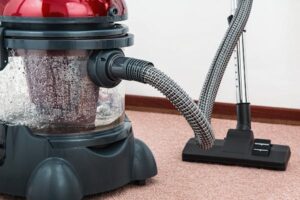Ways To Reduce Allergens and Refine Air Quality in Schools
10 February 2025
The Growing Urgency to Improve Indoor Air Quality in Schools
Classroom health has always been a significant concern for both teachers and parents, but in recent years, there’s been an increased focus on refining air quality and reducing allergens in schools. With growing awareness about environmental and health issues, there’s an increasing emphasis on creating healthier environments overall, not just in medical practices but also in everyday spaces like classrooms.
For example, it has been found that blue inhalers have a harmful environmental impact due to their hydrofluorocarbon propellants, which are potent greenhouse gases. The NHS estimates that blue inhalers account for 3pc of their carbon footprint. With doctors being advised to reduce inhaler use because of their environmental impact, there is a growing need for preventative measures to minimise asthma triggers that lead to asthma attacks at school in the first place. By focusing on improving air quality using hypoallergenic materials, and reducing allergens like dust mites and mould, schools can essentially adopt a proactive approach to reduce students’ dependency on inhalers.

Ultimately, the shift away from certain inhalers, due to their environmental impact, reinforces the growing urgency to improve the quality of indoor air in schools. It’s about creating spaces where asthma triggers are minimised, thus reducing the need for medication and improving overall student health.
Main Asthma Triggers in School
To effectively reduce allergens and create a healthier classroom environment, it’s essential to first identify the primary asthma triggers commonly found in schools. Understanding these triggers will help guide the actions needed to minimise their presence, ensuring a safer, more comfortable space for all students.
So, what are the main asthma triggers to watch out for in schools?
- Dust mites: These microscopic creatures thrive in warm, humid environments and are commonly found in carpets, soft furnishings, and bedding
- Mould: Mould can grow in damp areas like bathrooms, leaky ceilings, and around windows
- Pollen: Pollen from trees, grasses, and weeds can enter the classroom through open windows and doors
- Animal dander: Pets can bring dander (skin flakes) into the classroom on students’ clothing
- Chalk dust: Chalk dust can irritate the airways and trigger asthma symptoms
- Cleaning products: Strong-smelling cleaning products can also trigger asthma
- Pests: Cockroach and rodent droppings can be significant asthma triggers

Simple Steps to Reduce Allergens
Taking proactive steps to reduce allergens is essential for creating a healthier environment for both students and staff. While it may seem challenging, there are a variety of simple, effective measures you can take to decrease common asthma triggers. These actions can significantly improve air quality and help reduce asthma-related symptoms in your classroom.
- Regular cleaning: Frequent dusting, vacuuming, and wet mopping can help reduce dust mites, mould, and other allergens
- Air filters: High-efficiency particulate air (HEPA) filters can remove allergens from the air
- Ventilation: Good ventilation can help reduce moisture and prevent mould growth. Open windows when possible or use a ventilation system
- Hypoallergenic materials: Choose hypoallergenic curtains, tablecloths and any other classroom fabrics
- Pest control: Implement a pest management plan to prevent infestations
- Consider carpet tiles: While some may associate carpets with allergens, recent studies suggest carpeted floors reduce PM10
- Alternative writing materials: Use whiteboards or markers instead of chalk
- Safe cleaning products: Choose fragrance-free and non-toxic cleaning products

Carpeted Classrooms and Air Quality
A common misconception is that carpeted flooring exacerbates indoor allergens and reduces air quality. In reality, carpets can actually improve air quality by acting as a natural air filter by trapping dust, allergens, and other particulate matter. For example, as people walk across carpeted surfaces, dust and airborne particles are drawn down into the fibres, where they become trapped rather than floating freely in the air. By capturing these particles, carpets can significantly improve indoor air quality and help create a healthier environment, especially in spaces with high foot traffic, like classrooms.
Furthermore, carpets continue to trap particles until they are cleaned, meaning they can act as a long-term filtration system for indoor environments. This is particularly beneficial for individuals with respiratory conditions or allergies, as it reduces their exposure to common irritants that would otherwise circulate in the air. As a result, carpet tiles offer several benefits over hard flooring, particularly in environments like classrooms.
Additionally, recent studies have shown that carpeted floors can actually help reduce PM10, inhalable particles that are 10 micrometres or smaller, including dust, pollen, and mould spores, in classrooms. For example, the University of Surrey found that hardwood floors had twice as much PM10 pollution in the air than carpeted classrooms. Therefore, while carpets may trap some allergens, they can also help to reduce the overall level of PM10 in the air, improving overall air quality and making the environment healthier for students and staff, especially those with allergies or asthma.
The Role of Carpet Cleaning
Frequent cleaning helps eliminate particles like dust mites, pollen, and other irritants that accumulate in the carpet, which can otherwise contribute to poor air quality and trigger allergic reactions. In fact, properly maintained carpets are more effective at keeping allergens contained compared to hard flooring, where dust and particles can easily become airborne and contribute to poor air quality. It’s also important to note that fragrance-free and non-toxic cleaning products should be used when maintaining carpets, as these are less likely to release harmful chemicals into the air, ensuring a healthier environment for both students and staff.

Nevertheless , staying on top of maintenance can be challenging, particularly in large educational intuitions. Investing in low-maintenance solutions can help ease the burden by reducing the frequency and effort required for upkeep. Supacord, known for its low-maintenance and easy-to-clean properties, features a design with fewer fibre surfaces for dirt and debris to cling to, helping to maintain a cleaner and healthier learning environment with minimal effort.

Carpet Cleaning Has Additional Benefits
While regular carpet cleaning is necessary to reduce allergens in schools, it is also an invaluable and simple way to save your school money in the long run by extending the lifespan of your carpets and reducing the need for frequent replacements. To learn more about the best practices for maintaining your carpets and maximising their longevity, check out our guide to carpet maintenance.
Creating a Healthy Learning Environment
Overall, carpets, when properly maintained, offer significant advantages in creating a healthier and more comfortable environment, especially in classrooms. By trapping allergens and dust, they help improve air quality and reduce the risk of respiratory issues, making them an ideal choice for educational spaces. To ensure that your carpets continue to work for you, regular cleaning and maintenance are essential. If you’re looking to create a cleaner, healthier classroom environment, consider investing in high-quality, low-maintenance carpet options like Supacord.
Ready to make the change? Contact us today to learn more about our carpet solutions and how they can improve the air quality in your school.
